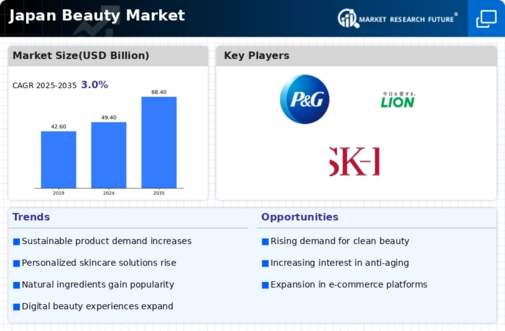Market Analysis
In-depth Analysis of Japan Beauty Market Industry Landscape
The global toothpaste market is experiencing a transformative phase, propelled by a heightened global awareness regarding oral hygiene. The increasing prevalence of dental problems, attributed to the rising consumption of sugar-based foods and inadequate oral care practices, is driving individuals worldwide to adopt meticulous oral care routines. This surge in awareness serves as a key determinant in the growth of the toothpaste market, with notable impacts on global oral health initiatives. Global Oral Health Challenges and Initiatives: The alarming increase in dental issues, including tooth decay, sensitivity, periodontal disease, and mouth sores, particularly among children, underscores the urgent need for enhanced oral care practices. In India, for instance, The Indian Dental Association (IDA) revealed that nearly 95% of the rural population suffers from gum disease, with only 50% utilizing toothpaste. Recognizing the critical need to address this disparity, the IDA initiated the National Oral Health Programme, aiming to achieve optimal oral health by 2020. This initiative exemplifies the commitment to raising awareness and promoting oral hygiene practices, especially in underserved populations. Market Growth Indicators: According to analysis by Market Research Future (MRFR), the global oral care market is anticipated to witness a Compound Annual Growth Rate (CAGR) of 5.5% from 2018 to 2025, reaching an approximate value of $42 billion by 2025. Notably, toothpaste commands the largest share in the oral care market, contributing nearly 50% of the revenue. The robust growth in the global oral care market, fueled by an escalating awareness regarding oral hygiene, serves as a significant driver for the increasing sales of toothpaste on a global scale. Key Trends Shaping the Toothpaste Market: 1. Awareness-Driven Adoption: The growing consciousness about oral hygiene is steering individuals toward adopting regular and proper oral care routines. This shift in consumer behavior is a testament to the effectiveness of awareness campaigns and initiatives that highlight the importance of oral health. 2. Preventive Focus: With the increasing prevalence of dental issues linked to poor oral hygiene, there is a growing emphasis on preventive oral care measures. Individuals are proactively seeking products that address specific concerns such as tooth sensitivity, decay prevention, and gum health, driving innovation in the toothpaste market. 3. Global Oral Health Programs: Initiatives like the National Oral Health Programme in India and similar endeavors worldwide are playing a pivotal role in shaping oral care trends. These programs not only raise awareness but also contribute to the widespread adoption of oral care products, particularly toothpaste, as an integral component of daily hygiene practices. 4. Market Dynamics: The toothpaste market's substantial share in the broader oral care market emphasizes its critical role in addressing global oral health challenges. As consumers increasingly recognize the preventive and therapeutic benefits of toothpaste, market dynamics continue to evolve, with a surge in demand for specialized variants catering to diverse oral care needs. The global toothpaste market is undergoing a paradigm shift driven by heightened awareness regarding oral hygiene. The intersection of market forces, innovative product offerings, and impactful oral health initiatives is reshaping consumer behavior and fueling the growth of the toothpaste market. As the world moves toward a future marked by optimal oral health, toothpaste emerges as a cornerstone in achieving this vision, contributing significantly to the broader landscape of global oral care.






Leave a Comment